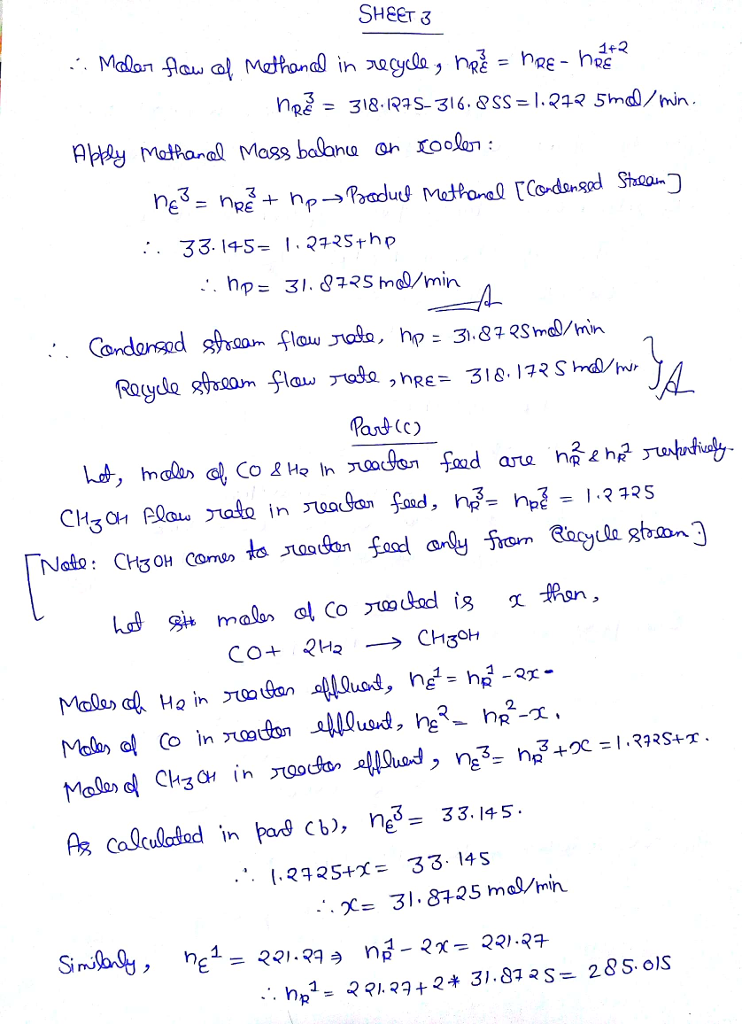Question
In: Other
Methanol (CH3OH) is produced by reacting carbon monoxide (CO) and hydrogen (H2). A fresh feed stream...
Methanol (CH3OH) is produced by reacting carbon monoxide (CO) and hydrogen (H2). A fresh feed stream containing CO and H2 joins a recycle stream and the combined stream is fed into a reactor. The reactor outlet stream flows at a rate of 350 mol/min and contains 10.6 wt% H2, 64.0 wt% CO, and 25.4 wt% CH3OH. The stream enters a cooler in which most of the methanol is condense. The liquid methanol is withdrawn as a product, and the gas stream leaving the condenser--which contains CO, H2, and 0.40 mole% uncondense CH3OH vapor is the recycle stream that combines with the fresh feed stream.
a. Draw the process flow diagram. Calculate the mole fraction of CH3OH, CO, and H2 present in the stream leaving the reactor.
b. Calculate the molar flowrate (moles/min) of condensed methanol stream and recycle stream.
c. Calculate the molar flowrate (moles/min) of CO and H2 present in the fresh feed.
d. What is the single-pass and overall conversion of CO?
Solutions
Expert Solution




DEAR STUDENT, IF YOU HAVE ANY QUERY FEEL FREE TO ASK. I SHALL TRY MY BEST TO REOLVE YOUR QUERY. THANK YOU.
DEAR STUDENT, OVERALL CONVERSION IS 100% FROM OTHER DEFINITION OF OVERALL CONVERSION WHICH IS :"MOLE OF CO FED TO PROCESS (=31.8725)-MOLES OF CO LEAVING PROCESS(=0)/MOLE OF CO FED TO PROCESS (=31.8725)= 100%.
Related Solutions
Methanol is produced by reacting carbon monoxide and hydrogen. A fresh feed stream containing CO and...
Methanol is produced by reacting carbon monoxide and hydrogen. A fresh feed stream containing CO and...
Methanol is produced by reacting carbon monoxide and hydrogen. A fresh feed stream containing CO and...
Methanol (CH3OH) is made by reacting gaseous carbon monoxide (CO) and gaseous hydrogen (H2). A. What...
Methanol, CH3OH, can be made from the reaction of carbon monoxide and hydrogen. CO(g) + 2...
Methanol has the formula of CH3OH and can be produced by the reaction of carbon monoxide...
Methanol (CH3OH) is produced via the partial oxidization of methane (CH4). The fresh feed contains methane...
Carbon monoxide gas reacts with hydrogen gas to form methanol. CO(g)+2H2(g)→CH3OH(g) A 1.05 L reaction vessel,...
The synthesis of methanol from carbon monoxide and hydrogen is carried out in a continuous vapor...
A mass of 7.75 g carbon monoxide is reacted with 8.04 g hydrogen to form methanol....
- List the relational operators recognized by Python, and explain their meanings
- Sports Corp has 11.8 million shares of common stock outstanding, 6.8 million shares of preferred stock...
- How does variety lead to paralysis of action?
- Consider a market consisting of several small pulp & paper mills operating in the South-east. These...
- What are the common types of social media? How do they differ from each other?
- Explain Business Intelligence in one page or less. Focus upon the concept that ‘BI’ is an...
- Given the following list of values, perform a binary search for the indicated search item. Use...
 Amanda K answered 3 years ago
Amanda K answered 3 years ago